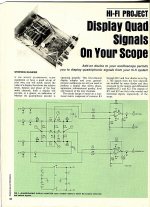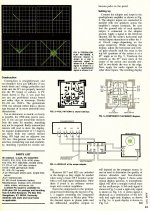Of course harmonic distortion will change the tonal balance. It is adding content by definition. Other bad cables can be excessively inductive or capacative and cause amplifier stability issues that may, briefly before the silence, cause a tonal shift.
If it were not for excessive distortion, no one would be bothering with "full range" speakers as just about everything in the treble is cone breakup or HD. 😀
I have to laugh at how a 3 foot magic cable can transform sound. Lets start with the mic wiring in the studio. Then count up the NE5532's in the console........ Fancy cables serve two functions. They kept a lot of stereo stores open a few years longer, and as bragging rights to young males. It really galls me when I see a Yellow Tag store selling a $200 power strip and $50 HDMI cables to someone with a $150 receiver and $400 TV. Money is better spend where it counts.
If it were not for excessive distortion, no one would be bothering with "full range" speakers as just about everything in the treble is cone breakup or HD. 😀
I have to laugh at how a 3 foot magic cable can transform sound. Lets start with the mic wiring in the studio. Then count up the NE5532's in the console........ Fancy cables serve two functions. They kept a lot of stereo stores open a few years longer, and as bragging rights to young males. It really galls me when I see a Yellow Tag store selling a $200 power strip and $50 HDMI cables to someone with a $150 receiver and $400 TV. Money is better spend where it counts.
Yes, you need to find a site where people don't know any physics.
See my current sig line.
Not sure about that. From what I have tried, even the Kamasutra violated the laws of physics.
Did anyone mention the wood block that kept your speaker cables off the floor? Foil triangles on door edges, Air transmission enhancers, or any device/technique that would reliably keep the magic smoke inside the wires of a TVR.
Did anyone mention the wood block that kept your speaker cables off the floor? Foil triangles on door edges, Air transmission enhancers, or any device/technique that would reliably keep the magic smoke inside the wires of a TVR.
That might carry more weight were it not for the fact that some people prefer carbon fibre cables which have very high resistivity (compared with metallic conductors).coresta said:NO.... at 290°K there is no less resistive metal than silver
However, I suppose you could be right in the sense that some people have to have 'the best'. Since the whole point of a cable is to conduct it must be obvious that the best conductor makes the best cable - except to those who know some elementary circuit theory and can do a little arithmetic.
Last edited:
Shootz! In my tests many people preferred nice red clay mud over copper and other conductors. Maybe I need to sell mud cables.
Pano, exactly my point, made earlier in a rather roundabout tongue in cheeck way. If a bucket of mud is indistinguishable from a good interconnect, how on earth could anyone tell the difference between the two best conducting metals we know?
Its amazing to see how fools can't see that this thread
Silver tonearm wire
provides absolute indisputable proof that there is an audible difference between cables and wires. The fact that different cables and wires affect the separation with quadraphonic signals and FM stereo signals has been proven. You could put some kind of visual indication in the system such as level detectors for each channel, but the fact that you can hear the sound from each speaker is enough to show that separation was improved by the silver wires and cables.
Quad scopes exist
Anyone knows WHEN IT'S QUAD by using a Technics SH-3433 AUDIOSCOPE
Silver tonearm wire
provides absolute indisputable proof that there is an audible difference between cables and wires. The fact that different cables and wires affect the separation with quadraphonic signals and FM stereo signals has been proven. You could put some kind of visual indication in the system such as level detectors for each channel, but the fact that you can hear the sound from each speaker is enough to show that separation was improved by the silver wires and cables.
Quad scopes exist
Anyone knows WHEN IT'S QUAD by using a Technics SH-3433 AUDIOSCOPE
Simple quad scope. You can get a better version here
http://www.quadraphonicquad.com/for...S-QUAD-by-using-a-Technics-SH-3433-AUDIOSCOPE
http://www.quadraphonicquad.com/for...S-QUAD-by-using-a-Technics-SH-3433-AUDIOSCOPE
Attachments
Last edited:
NO.... at 290°K there is no less resistive metal than silver 😉
Silver has 'more free conductive loads' than copper, and
the 'ability of the load carriers to move' is higher for silver than for copper.
You can find this numbers in physic and engineering data books.
Its amazing to see how fools can't see that this thread
Silver tonearm wire
provides absolute indisputable proof that there is an audible difference between cables and wires.
I felt a bit sorry for the one guy who, early on, explained exactly was going on (though his statement about electrons flowing wasn't correct), and was then roundly ignored by people who desperately wanted to play with wires.
Do you mean the 1st post in that thread? I don't see anything there that says silver worked better or worse. What am I missing? Can you point out the text or the post number you are referring to, please?Its amazing to see how fools can't see that this thread
Silver tonearm wire
provides absolute indisputable proof that there is an audible difference between cables and wires.
EDIT: I see that SY has read further into it than I.
The linked thread about silver tonearm wire shows that cable geometry can affect HF crosstalk. Nothing relevant about silver.
I would guess that copper has 'more free conductive loads' than mud, yet both can act as good interconnects. Your point is?210 said:Silver has 'more free conductive loads' than copper, and
the 'ability of the load carriers to move' is higher for silver than for copper.
Its amazing to see how fools can't see that this thread
Silver tonearm wire
provides absolute indisputable proof that there is an audible difference between cables and wires.
As I said yesterday, I read it, and it doesn't say what you seem to be claiming it says. Furthermore, nobody here would say that different cables can't sound different. However, audible differences in cables are caused by differences in the measurable electrical properties of the cables, and their interaction with the source and load impedances that the cables connect. No magic.
Hence, any two normal, competently made cables, used in a normal system, will not produce significant sonic differences. A cable with excessive capacitance will cause high-frequency roll-off, especially if driving a low impedance load. Quadraphonic systems rely on information encoded on ultrasonic carrier frequencies, and make unusual demands on high-frequency response of the circuit.
You should re-read that thread you posted above. Pay attention this time, and count how many things the poster changed which affected the performance of his CD-4 demodulator. Tonearm wire, physical layout of wire, VTA, VTF, RCA jacks, interconnects... But yeah, it must be the silver.
Do you really find it necessary to call people who don't agree with you "fools"?
Well that's what I was thinking, too. But what do I know?If a bucket of mud is indistinguishable from a good interconnect, how on earth could anyone tell the difference between the two best conducting metals we know?
An interesting aside to that test is that 3 people were able to identify the original file from the loops - tho they couldn't tell the loops apart. To me that points a finger at the DA/AD section, or more likely its analog section. I have found a better DA/AD and will repeat the tests.
Pano, if you're still 😕, you should try yourself : find 4x 3ft of 12AWG CuAg PTFE wire and connect them twisted to 4 Cinch , then insert this out of your CD player to your preamp and listen 😉
you think Pano tried Mud, Custard, Beer etc. first and left it there, with no previous experimentation?
*sound of repeatedly skipping vinyl groove* 😉I suspect it is because silver is visually so bright. Something which looks so nice just has to sound better!
Sorry. People keep saying the same silly things. I keep giving the same sensible answers. Sometimes I may accidentally quote, without realising it, someone else's sensible answer.
Well, there was a bit more to it than that ... the poorer conduits were getting noisier and noisier, you had to play with, filter the recordings to strip away the grunge, and adjust levels. In the worst connections the low level detail was getting quite badly mangled - putting a 'difficult' recording through the different routes would have made the variations much more obvious.An interesting aside to that test is that 3 people were able to identify the original file from the loops - tho they couldn't tell the loops apart. To me that points a finger at the DA/AD section, or more likely its analog section. I have found a better DA/AD and will repeat the tests.
- Status
- Not open for further replies.
- Home
- Member Areas
- The Lounge
- Funniest snake oil theories

